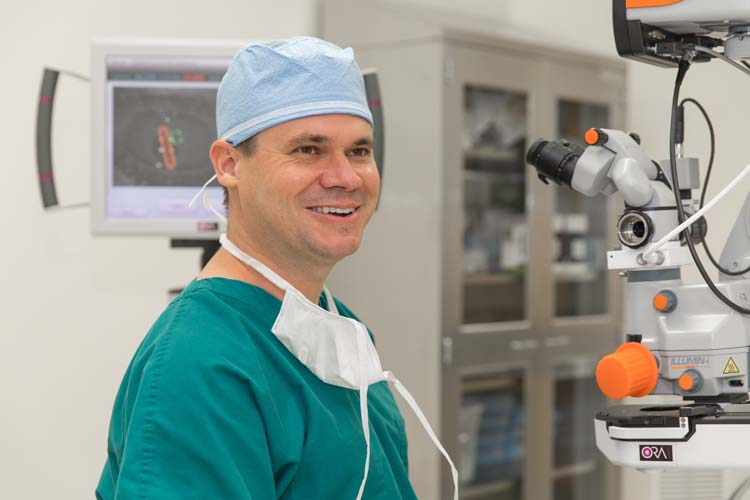Dr. Paul Minotty, dean of the New Vision Eye Center team, was struck by a quote from a recent conference he attended in Orlando. The speaker’s words, according to Minotty, were these: “The future doesn’t exist because we haven’t created it yet.”
Maybe.
But Dr. Stephen Tate, also with New Vision, might just disagree.
Specifically, Tate points to two brand-new additions to the New Visions optical arsenal: the Ocular Refractive Analysis system, or ORA, for cataract surgeries; and the VISCO 360 visco-surgical system, which is described as the world’s first non-implantable micro-invasive glaucoma surgery device.
If these new additions aren’t the future, they are – at the very least – the current state of the art in ophthalmology surgery.
That’s good news for the many millions of Americans in Vero Beach and across the country who have cataracts, as well as to the 3 million more who suffer from glaucoma.
“Cataracts,” explains Tate, “are just a clouding of the lens inside the eye. By the time that you’re 60, 70 or 80 years old, the lens in your eye is 60, 70, 80 years old. It just starts to get hazy and cloudy and typically will get a bit yellowish and brown over time. Eventually it gets cloudy enough that it starts to affect the vision.”
The solution? A surgical replacement of that lens.
According to the American Academy of Ophthalmology, the ORA “uses a wavefront analysis of the eye during surgery at the point after a cataract is removed and before the replacement intra-ocular lens is inserted. The information obtained is then plugged into a mathematical formula that can then calculate the proper intra-ocular lens” for each individual patient.
In other words, it provides eye surgeons like Tate with accurate, real-time analysis of your eye during surgery so that they select the best-fitting replacement lens.
Minotty says this wavefront analysis system is not available anyplace else on the Treasure Coast; when asked what it cost, all he would reveal was that it was “in the six-figure range.”
In earlier versions of cataract surgery, measurements were taken before any incisions were made, but even the most accomplished surgeons would admit there was always a margin of error to deal with in selecting the proper replacement lens.
Factors including any irregularities of the cornea or the presence of an unusually thick or dense cataract could throw off those pre-operative calculations.
Because the ORA system provides real-time calculations during the surgery – including after the eye’s natural lens is removed – it allows Tate and his colleagues to select the ideal replacement lens based on the eye’s physiology. In many cases it can minimize or even eliminate the need for a patient to wear glasses after their cataract surgery.
Tate puts it more simply. “It is a system designed to increase the percentage of people who are glasses-free” after cataract procedures, adding, “It also helps to improve astigmatism correction outcomes.”
“The ORA,” Tate explains, “can take extremely accurate measurements of the astigmatism and also extremely accurate measurements of what type of implant to put in the eye.”
“Let’s pretend you’re somebody who’s very, very near-sighted,” Tate continues. “If you decide that you want to have clear vision at distance after your cataract surgery, we then select the lens implant strength that would be appropriate to put in the eye that would then correct your near-sightedness for you.”
Clearly excited about the new, high-tech tools in his optical toolbox, Tate turns the conversation to the VISCO 360.
It is, he says, “part of an increasing trend in ophthalmology of trying to find less invasive, safer surgeries for patients with glaucoma that can be used earlier in the disease process.”
Glaucoma is caused by a build-up of pressure on the optic nerve, and if left untreated can and does result in permanent blindness.
“Traditional glaucoma surgeries like the trabeculectomy or tube shunts, are surgeries that very powerfully lower eye pressure,” Tate explains, “but the problem with those older surgeries is they have a relatively high complication rate and a relatively high failure rate. And so, traditionally, those procedures have been sort of saved for patients who are really in trouble or who really don’t have any other options available to them.
The VISCO 360, according to Tate, is part of a MIGS – or micro-invasive glaucoma surgery – trend. Unlike a stent procedure, nothing is left inside the eye but the procedure can dramatically ease the pressure on the optic nerve. In fact, Tate says it is “more powerful at lowering eye pressure” than any stent.
Pausing only briefly, Tate then adds, “We do currently have a clinical study going on for patients with cataracts and glaucoma. People having cataract surgery who also have glaucoma would qualify. It is a post-approval FDA study, so anybody interested in that should call the [New Vision] office” and see if they qualify.
Dr. Stephen Tate is with New Vision Eye Center at 1055 37th Place in Vero Beach, directly across from the hospital. The phone number is 772-257-8700.

